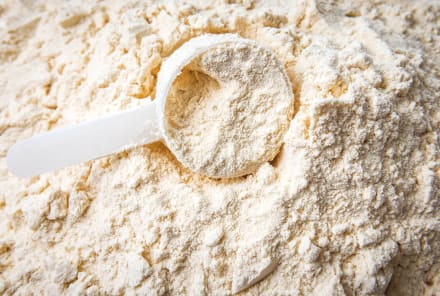Advertisement

Nonstick pots and pans are designed to make cooking easier and cleaning up a breeze. If you’ve struggled to lose weight no matter what type of diet you’ve tried, the cookware you’re using could be to blame! Researchers from Harvard University recently conducted a study, published in the scientific journal PLOS Medicine, showing how nonstick cookware is linked to weight gain. They found people with the highest levels of perfluoroalkyl substances (PFAS), gained the most weight. PFAS are chemicals used to make products more stain-resistant, waterproof, or nonstick. Findings from this study showed people with higher levels of PFAS in their bloodstream also have a lower resting metabolic rate and burn fewer calories throughout the day. PFAS have also been associated with the prevalence of osteoporosis in women and thyroid dysfunction.
PFAS fall into the category of obesogens, or "endocrine disrupters," which are chemical compounds that increase the fat cells you have, decrease the calories you burn, and alter the way your body manages hunger. Because obesogens cause the liver to become insulin resistant, the body must produce more insulin to store energy, which causes an increased fat storage, which can lead to obesity. Obesogens aren’t just found in your cookware; they are also in plastic containers and plastic bottles. While eating fast food is often blamed as a major contributing factor to the rising obesity epidemic, the wrappers and containers the food is served in are manufactured with fattening PFAS. Silent Spring Institute, the Environmental Working Group, and the Green Science Policy Institute teamed up with researchers at the University of Notre Dame and the Environmental Protection Agency to analyze more than 400 wrappers and containers from 27 fast-food chains throughout the country. About half the wrappers tested contained PFAS.
What's the problem with obesogens?
In the United States, the percentage of children and adolescents affected by obesity has more than tripled since the 1970s.1 While many experts blame this increase on a poor diet and lack of exercise, according to the National Institute of Environmental Health Sciences and the Environmental Protection Agency, being in contact with obesogens in early childhood can lead to unhealthy, excessive weight gain. Additionally, researchers at the University of Michigan, University of California–Berkeley, and Columbia University2 report that 7- to 9-year-old children exposed to higher levels of bisphenol A (BPA), a common food packaging ingredient, increased their percentage of body fat.
Another leading cause of obesity, especially in children, is high-fructose corn syrup (HFCS). This obesogen, found in many food products, can wreak havoc on the insulin and appetite-regulating hormones, fooling you into thinking you’re hungry, even if you are not. Research published in the Journal of Clinical Endocrinology & Metabolism showed that ghrelin, the hormone that makes you feel hungry was not suppressed after eating HFCS3. In another study published by the Journal of Clinical Investigation3, researchers found participants assigned to a high-fructose drink gained more visceral fat compared to the group with a high-glucose drink. In other words, high-fructose corn syrup intake is more likely to create abdominal fat than regular sugar! HFCS is cheaper than sugar, thanks to the government’s farm bill corn subsidies, which is why it’s found in so many food and beverages.
Where are obesogens found?
Research from the University of Texas Health Science Center and the U.S. government suggests that many of the most popular supermarket foods—including dairy, meats, condiments, drinks, and pizza—are contaminated with a variety of plastic chemicals called phthalates. In addition to obesity, these chemicals have been linked4 to asthma, attention-deficit hyperactivity disorder, breast cancer, type 2 diabetes, altered reproductive development, and male fertility issues. While it may seem like you can’t escape the plethora of obesogens surrounding you, it is possible to avoid exposure to many of them. Knowledge is power, and by paying attention to labels and how your food is grown, raised, and packaged, you can live a healthier and leaner life.
The most common obesogens and how to avoid them.
Bisphenol-A (BPA) and phthalates:
Traditionally used worldwide in plastics for food and drink storage, BPA mimics estrogen and has been associated with impaired reproductive function. It’s also an obesogen. A 2012 study published in the International Journal of Obesity found that BPA causes a biochemical cascade within fat cells that increases inflammation and promotes fat-cell growth5. BPA is used to make microwave popcorn bags, lids of some glass jars of pickles, jellies, salsa, baby food, and more, along with many coffee cans, cooking oil tins, and soda cans. They are also found in thermal paper items including receipts, event and cinema tickets, ATM receipts, and airline tickets.
Also called "plasticizers," phthalates are a group of chemicals used to make plastics more flexible and harder to break. These obesogens are found in dairy products due to the plastic tubing used to milk cows. You’ll also find them in meats, tap water that’s been tainted by industrial waste, and in the pesticides sprayed on conventional fruits and vegetables. They can show up in shampoo, hair spray, deodorant, nail polish, insect repellent, and even your shower curtains.
To avoid BPA and phthalates, you can search the Environmental Working Group’s database to check out what products contain these obesogens. Their searchable database gives you access to 16,000 processed foods and drinks that are packaged in materials containing phthalates and BPA. They also have an extensive list of chemical-free skin care products. When you’re out shopping, always look for products labeled "BPA-free," and stay clear of plastic containers with the number 3, 6, or 7 on the bottom. Instead, look for the numbers 2, 4, or 5 recycle code on them, which means they are BPA- and phthalate-free. Another proactive step you can take is to buy eco-friendly alternatives to plastic bottles for hot or cold liquids.
After you shop for obesogen-free foods and beverages, it’s time to pay the cashier. When she hands you the receipt, avoid touching it! Instead, have the cashier put the receipt in your bag. If you touch it, be sure to wash your hands. Also never put a thermal-imaging receipt from a cash register into your wallet because this can contaminate your currency with BPA, making your paper money a secondary source of exposure.
Herbicides and pesticides:
Thanks to pesky bugs that enjoy eating crops, many farmers spray pesticides on them to repel the insects. Weeds are another constant struggle for farmers, so it’s herbicides to the rescue! While adding these may solve their dilemma, it exposes consumers to some potentially toxic chemicals. Herbicides can disrupt normal cellular mitochondrial function and have been shown to cause insulin resistance in animals. Pesticides are linked to obesity, diabetes, and other morbidities. Department of Agriculture data shows that the average American is exposed to 10 or more pesticides every day, via diet and drinking water. Ninety percent of these are endocrine disrupters, which have been linked to obesity.
You can minimize your exposure to these obesogens by buying local organic produce whenever possible. At the grocery store, look for "USDA Certified Organic" on the label. This ensures the product does not contain pesticides or herbicides. Don’t limit your organic products to food alone—look for organic varieties of body care products and clothing as well.
Hormones and antibiotics.
There’s an old saying: "You are what you eat." While this is true, you are also what your meat eats. This includes the estrogen, progesterone, and testosterone that’s being used to increase the weight of cattle. When you eat the cattle, these same substances can also increase your weight! A study in the International Journal of Obesity from researchers at 10 different universities, including Yale University School of Medicine and Johns Hopkins University, found that the use of steroid hormones in meat production and on conventional dairy farms could be contributing to obesity.
Then there are the antibiotics used in chicken and farmed-raised fish, to help them fight off infection. These antibiotics also aid in fattening up fish and chicken and can do the same when humans eat them, which is why antibiotics are considered obesogens.
To avoid consuming hormones and antibiotics in your food, look for a "USDA Certified Organic" label. Some companies aren’t certified but claim they offer conditions comparable to organic. Many products display a "USDA Process Verified" shield that they pay for. Don’t put a lot of credence in this label. It’s not the same thing as being "USDA Certified Organic."
Perfluorooctanoic acid:
Perfluorooctanoic acid (PFOA) is a surfactant used in nonstick cookware, like Teflon. PFOA has been identified in bodies of water and in a variety of land and water animals6. PFOA has also been detected in the blood of more than 98 percent of the general U.S. population. This chemical is considered an obesogen because it can cause an endocrine dysfunction that has been linked to obesity7. Other negative effects of PFOA have been documented including thyroid disease, kidney disease, and various cancers.
To reduce your exposure to PFOA, throw away all your pots and pans that are coated with a nonstick material. Purifying your tap water through distillation or reverse osmosis before drinking it will also minimize your exposure to this obesogen.
It’s not necessarily food itself, but how it’s grown, harvested, stored, and cooked that has become the catalyst to the growing obesity epidemic. Being more proactive, reading labels, and learning where your food comes from are prudent approaches to safeguarding your well-being and FINALLY losing those unwanted pounds.
Looking to find your happy weight? These 7 real people share what actually worked for them.
7 Sources
- https://www.cdc.gov/healthyschools/obesity/facts.htm
- https://www.ncbi.nlm.nih.gov/pmc/articles/PMC5047776/
- https://www.ncbi.nlm.nih.gov/pubmed/15181085
- https://www.ncbi.nlm.nih.gov/pmc/articles/PMC3385443/
- https://www.nature.com/articles/ijo2012173
- https://www.cdc.gov/biomonitoring/PFOA_FactSheet.html
- https://www.ncbi.nlm.nih.gov/pmc/articles/PMC3279464/
Watch Next
Enjoy some of our favorite clips from classes
Enjoy some of our favorite clips from classes
What Is Meditation?
Mindfulness/Spirituality | Light Watkins
Box Breathing
Mindfulness/Spirituality | Gwen Dittmar
What Breathwork Can Address
Mindfulness/Spirituality | Gwen Dittmar
The 8 Limbs of Yoga - What is Asana?
Yoga | Caley Alyssa
Two Standing Postures to Open Up Tight Hips
Yoga | Caley Alyssa
How Plants Can Optimize Athletic Performance
Nutrition | Rich Roll
What to Eat Before a Workout
Nutrition | Rich Roll
How Ayurveda Helps Us Navigate Modern Life
Nutrition | Sahara Rose
Messages About Love & Relationships
Love & Relationships | Esther Perel
Love Languages
Love & Relationships | Esther Perel


















